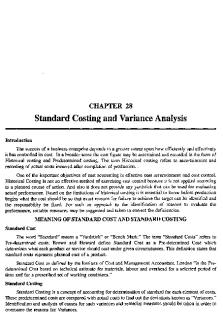CPA REVIEW SCHOOL OF THE PHILIPPINES Manila MANAGEMENT ADVISORY SERVICES STANDARD COSTING & VARIANCE ANALYSIS DOC

| Title | CPA REVIEW SCHOOL OF THE PHILIPPINES Manila MANAGEMENT ADVISORY SERVICES STANDARD COSTING & VARIANCE ANALYSIS |
|---|---|
| Author | James Abiel |
| Pages | 1 |
| File Size | 216.5 KB |
| File Type | DOC |
| Total Downloads | 700 |
| Total Views | 1,004 |
Summary
CPA REVIEW SCHOOL OF THE PHILIPPINES Manila MANAGEMENT ADVISORY SERVICES STANDARD COSTING & VARIANCE ANALYSIS THEORY 1. Which one of the following terms best describes the rate of output which qualified workers can achieve as an average over the working day or shift, without over-exertion, provi...
Description
CPA REVIEW SCHOOL OF THE PHILIPPINES Manila MANAGEMENT ADVISORY SERVICES STANDARD COSTING & VARIANCE ANALYSIS THEORY 1. Which one of the following terms best describes the rate of output which qualified workers can achieve as an average over the working day or shift, without over-exertion, provided they adhere to the specified method of working and are well motivated in their work? A. Standard time B. Standard hours C. Standard unit D. Standard performance 2. The best characteristics of a standard cost system is A. standard can pinpoint responsibility and help motivation B. all variances from standard should be reviewed C. all significant unfavorable variances should be reviewed D. standard cost involves cost control which is cost reduction 3. Standard costs are used for all of the following except: A. income determination C. measuring efficiencies B. controlling costs D. forming a basis for price setting 4. Standard costs are least useful for A. Measuring production efficiency C. Job order production systems B. Simplifying costing procedures D. Determining minimum inventory levels 5. To which of the following is a standard cost nearly like? A. Estimated cost. B. Budgeted cost. C. Product cost. D. Period cost. 6. A difference between standard costs used for cost control and budgeted costs A. Can exist because standard costs must be determined after the budget is completed. B. Can exist because standard costs represent what costs should be while budgeted costs represent expected actual costs. C. Can exist because budgeted costs are historical costs while standard costs are based on engineering studies. D. Can exist because establishing budgeted costs involves employee participation and standard costs do not. 7. Normal costing and standard costing differ in that A. the two systems can show different overhead budget variances. B. only normal costing can be used with absorption costing. C. the two systems show different volume variances if standard hours do not equal actual hours. D. normal costing is less appropriate for multiproduct firms 8. When standard costs are used in a process-costing system, how, if at all, are equivalent units of production (EUP) involved or used in the cost report at standard? A. Equivalent units are not used. B. Equivalent units are computed using a special approach. C. The actual equivalent units are multiplied by the standard cost per unit. D. The standard equivalent units are multiplied by the actual cost per unit. 9. The type of standard that is intended to represent challenging yet attainable results is: A. theoretical standard D. normal standard B. flexible budget standard E. expected actual standard MSQ-04 Page 1...
Similar Free PDFs

CPA REVIEW SCHOOL OF THE PHILIPPINES
- 11 Pages

CPA REVIEW SCHOOL OF THE PHILIPPINES
- 18 Pages

CPA Review School OF THE Philippines
- 18 Pages

CPA REVIEW SCHOOL OF THE PHILIPPINES
- 10 Pages
Popular Institutions
- Tinajero National High School - Annex
- Politeknik Caltex Riau
- Yokohama City University
- SGT University
- University of Al-Qadisiyah
- Divine Word College of Vigan
- Techniek College Rotterdam
- Universidade de Santiago
- Universiti Teknologi MARA Cawangan Johor Kampus Pasir Gudang
- Poltekkes Kemenkes Yogyakarta
- Baguio City National High School
- Colegio san marcos
- preparatoria uno
- Centro de Bachillerato Tecnológico Industrial y de Servicios No. 107
- Dalian Maritime University
- Quang Trung Secondary School
- Colegio Tecnológico en Informática
- Corporación Regional de Educación Superior
- Grupo CEDVA
- Dar Al Uloom University
- Centro de Estudios Preuniversitarios de la Universidad Nacional de Ingeniería
- 上智大学
- Aakash International School, Nuna Majara
- San Felipe Neri Catholic School
- Kang Chiao International School - New Taipei City
- Misamis Occidental National High School
- Institución Educativa Escuela Normal Juan Ladrilleros
- Kolehiyo ng Pantukan
- Batanes State College
- Instituto Continental
- Sekolah Menengah Kejuruan Kesehatan Kaltara (Tarakan)
- Colegio de La Inmaculada Concepcion - Cebu











